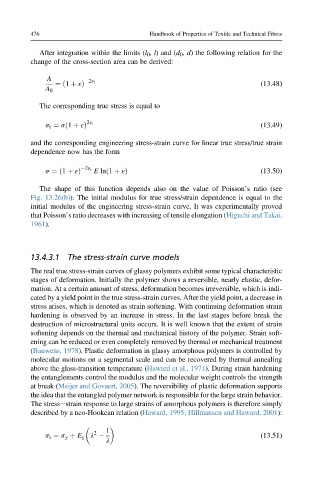Page 503 - Handbook of Properties of Textile and Technical Fibres
P. 503
476 Handbook of Properties of Textile and Technical Fibres
After integration within the limits (l 0 ,l) and (d 0 ,d) the following relation for the
change of the cross-section area can be derived:
A
2n t
¼ð1 þ εÞ (13.48)
A 0
The corresponding true stress is equal to
2n t
s t ¼ sð1 þ εÞ (13.49)
and the corresponding engineering stress-strain curve for linear true stress/true strain
dependence now has the form
2n t
s ¼ð1 þ εÞ E lnð1 þ εÞ (13.50)
The shape of this function depends also on the value of Poisson’s ratio (see
Fig. 13.26(b)). The initial modulus for true stress/strain dependence is equal to the
initial modulus of the engineering stress-strain curve. It was experimentally proved
that Poisson’s ratio decreases with increasing of tensile elongation (Higuchi and Takai,
1961).
13.4.3.1 The stress-strain curve models
The real true stress-strain curves of glassy polymers exhibit some typical characteristic
stages of deformation. Initially the polymer shows a reversible, nearly elastic, defor-
mation. At a certain amount of stress, deformation becomes irreversible, which is indi-
cated by a yield point in the true stress-strain curves. After the yield point, a decrease in
stress arises, which is denoted as strain softening. With continuing deformation strain
hardening is observed by an increase in stress. In the last stages before break the
destruction of microstructural units occurs. It is well known that the extent of strain
softening depends on the thermal and mechanical history of the polymer. Strain soft-
ening can be reduced or even completely removed by thermal or mechanical treatment
(Bauwens, 1978). Plastic deformation in glassy amorphous polymers is controlled by
molecular motions on a segmental scale and can be recovered by thermal annealing
above the glass-transition temperature (Haward et al., 1971). During strain hardening
the entanglements control the modulus and the molecular weight controls the strength
at break (Meijer and Govaert, 2005). The reversibility of plastic deformation supports
the idea that the entangled polymer network is responsible for the large strain behavior.
The stressestrain response to large strains of amorphous polymers is therefore simply
described by a neo-Hookean relation (Haward, 1995; Hillmansen and Haward, 2001):
1
2
s t ¼ s y þ E y l (13.51)
l

